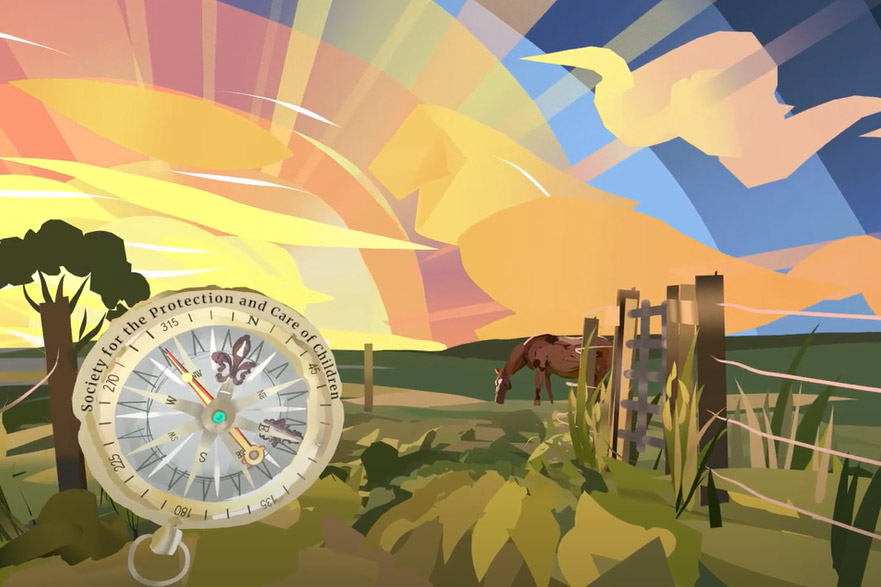Telling the story of the Society for the Protection and Care of Children using virtual reality
Faculty and student in RIT’s College of Art and Design leverage their skills for good
The trailer for the “Our Compass” VR experience is available on YouTube.
The Society for the Protection and Care of Children (SPCC) was founded in Rochester, N.Y., in 1875, and yet there are many people in the city who are not familiar with the organization. Capturing the positive impact the SPCC has on families, and sharing the many valuable resources the organization provides, was a challenge that members of RIT’s College of Art and Design accepted.
Susan Lakin, professor in the School of Photographic Arts and Sciences, has worked with the SPCC for many years leveraging RIT’s expertise to help the organization, including producing a virtual therapeutic tool for children and families in 2019. The continued partnership has resulted in a new virtual reality (VR) experience titled “Our Compass,” which illustrates how an individual working with the SPCC can emerge from their trauma and thrive in a new light.
“As a new form of storytelling, VR can create an immersive stage for the viewer to experience the embodiment of someone else,” said Lakin. “Having worked with SPCC for a number of years, I saw the potential for VR to help bring attention to the organization’s deep roots in Rochester and tell their story from the perspective of the families they serve.”
Save the date: Experience “Our Compass” in person
“Our Compass” will be available for viewing on Nov. 18 at the 2022 Frameless XR Symposium, hosted by Frameless Labs. More details can be found on the lab's website.
This VR experience follows the story of Mary Ellen Wilson, who was at the center of the first child protection case in the United States, through the lens of contemporary survivors of sexual abuse and domestic violence. The experience addresses how the guidance of SPCC can provide a safe environment to heal, and how the organization’s resources can help turn lives around in a positive direction.
To bring the idea to life, Lakin worked with Frank Deese, associate professor in the School of Film and Animation, Isabelle Anderson ’22 (new media design), and the SPCC.
“RIT has a reservoir of student talent in the arts and sciences that could be of great value to a lot of nonprofits like the SPCC and others doing good work in the community,” said Deese. “Also, the younger generations are more and more looking for meaningful careers centered on making the world a better place. Both Susan and I believe RIT should take the lead training students to be of assistance to nonprofits.”
As the project came together, the SPCC connected the RIT team with Justice DeCroce, who has worked with the SPCC for several years. DeCroce joined the team as a narrator and collaborator on the VR experience and came up with the metaphor of a guiding compass which became the lead symbol of the project.
“The visuals are a metaphor that people can think and meditate on, but it also shows the harsh reality that some people live with. Sometimes people don’t, or can’t, speak up when they’re in those dark places,” said DeCroce. “That’s why we need to show them these resources at the SPCC, to show them that they don’t have to do it alone. If they trust in our compass, they can start out on a fresh foot every day.”
The SPCC specializes in supporting families whose lives have been impacted by trauma by helping parents and children realize their potential and create healthier relationships with each other. According to Clarice Lazary, vice president of programs and communications at SPCC, community members being unfamiliar with the organization is somewhat of a good thing, meaning they haven’t needed the organization’s resources. However, to ensure they can best serve the community, the SPCC needed help raising awareness and sharing its resources.
“For years our board has said we need to have a movie or commercial to help explain what we do,” said Lazary. “The amount of time that the three of them [Lakin, Deese, and Anderson] put into this project resulted in something I never would have envisioned. Something that lets you experience what it would be like to come out of the other side of darkness. Their vision goes way beyond any of our capabilities, even if we had a larger marketing department.”
Lakin and Deese emphasized that having students like Anderson engage in community-based research and service with local nonprofits not only contributes to the common good, but also gives them practical knowledge and experience which results in “civic-minded graduates.”
“What really solidified the project for me was when the SPCC junior board came to visit and view the experience before the final screening. When I saw their reactions, how happy they were with it, and how moved by it they were, I thought to myself, ‘OK, this was all worth it,’” said Anderson. “Being involved with this project has completely inspired and changed my career path. I’m really passionate about using VR for empathy and VR for good.”




